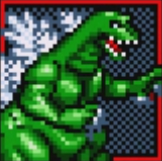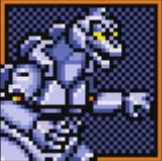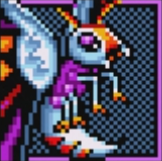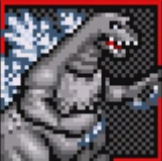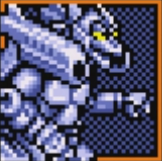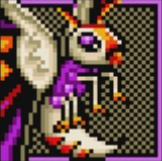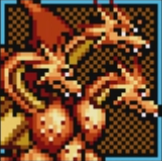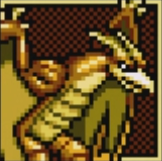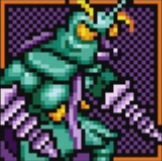Template:Game Infobox
Godzilla: Domination! (ゴジラ怪獣大乱闘アドバンス, Gojira: Kaijū Dairantō Adobansu, lit. Godzilla: Great Monsters Fray Advance) is a 2002 video game developed by WayForward Technologies for the Gameboy Advance. Its U.S. publisher was Infogrames (Atari).
Story
Meteor X appears over Tokyo 2 and starts projecting magnetic waves which causes neurological damage to several monsters, causing them to go berserk. The monsters begin to attack Earth and its neighboring planets (led by Mecha-King Ghidorah), however, one monster remains unaffected by the waves and it's up to it to stop the others and destroy Meteor X.
Gameplay
- The eight-level Story Mode culminates in a fight against an enormous Mecha-King Ghidorah.
- Custom Mode allows play against up to three computer-controlled opponents. The player controls the monster selection, arena, difficulty level, and teams.
- In Versus Mode, 2-4 players can play against each other via Gameboy Advance Game Link Cable. The Single Pak option enables multiplayer battles with only one Godzilla: Domination! cartridge, though players can only use Godzilla.
- Six different monsters are available to play.
- There are seven different arenas to play in: Tokyo 2, Glacier (2 variations), Nova (2 variations), Meteor Z, Moon Base.
- Support for up to six different languages: English, French, German, Italian, Spanish, Japanese.
- The score after each level is determined by monsters defeated, structures destroyed, vehicles destroyed, health remaining, and time remaining. Losing a battle will significantly reduce it.
Characters
- Godzilla - The King of the Monsters himself. Godzilla is one of the slower characters, but packs a punch.
- Level 1 Special: Godzilla fires his atomic breath instantly at point blank range.
- Level 2 Special: Godzilla leaps into the air, curls into a ball and bodyslams his opponent.
- Level 3 Special: Godzilla activates his healing factor and regains health.
- Mechagodzilla - Godzilla's mechanical doppelganger. He is the slowest, yet most powerful playable character.
- Level 1 Special: Mechagodzilla deploys rocket launchers from his shoulders and fires a volley.
- Level 2 Special: Mechagodzilla leaps into the sky and off the screen, then lands onto the enemy with a powerful stomp.
- Level 3 Special: Mechagodzilla opens airvents to stop from overheating by releasing his steam. Now cooler, Mechagodzilla can endure longer and the steam is hot enough to hurt other kaiju.
- Kiryu - Only in the Japanese version in place of the Heisei Mechagodzilla. Kiryu has all of the same abilities as the Heisei Mechagodzilla, and the only differences are cosmetic.
- King Ghidorah - Godzilla's arch-nemesis. He makes an solid choice for beginners due to his evenly-balanced battle stats.
- Level 1 Special: King Ghidorah fires from its mouth magnetic blasts.
- Level 2 Special: King Ghidorah fires its signature lightning bolts, attacking everything above or to either side of it.
- Level 3 Special: King Ghidorah flies, then bodyslams on his enemy.
- Mothra - Mothra moves fairly fast and can be a very tricky monster. However, her attacks are not the strongest.
- Level 1 Special: Mothra summons a psudo-larva baby that explodes.
- Level 2 Special: Mothra flaps its poisonous wings, creating a cloud of toxic pollen that lasts for several seconds.
- Level 3 Special: Mothra fires lightning from her wings.
- Megalon - Megalon moves swift and wields considerable power. He's also capable of attacking in very quick succession.
- Rodan - The swiftest monster of the game, yet possesses the least power.
- Mecha-King Ghidorah (Unplayable) - Mecha-King Ghidorah is about 3-4 times more massive than the other monsters and is encountered on the last level, Meteor X. His gravity beams were replaced by energy blasts and fireballs.
- Connie Matsu - A reporter for the Godzilla Watch Newsroom, she is on the main menu and the story mode. She also reports on where the main monster is and also tells what happened to your monster after defeating Mecha-King Ghidorah.
Regional Differences
Any changes to monsters are cosmetic and do not affect or change their abilities or battle stats.
- Box Art - Rather than reusing Godzilla: Destroy All Monsters Melee's box art as in the American version of the game, the Japanese box features new artwork of the game's roster of kaiju drawn in a super-deformed or "chibi" style. As the game was released around the same time as Godzilla: Tokyo S.O.S., the box art prominently features Godzilla, Mothra and Kiryu, with the other monsters in the background. A special edition of the game was sold in Japan which included miniature figures of Godzilla, Mothra and Kiryu.
- Title - The Japanese title is (ゴジラ怪獣大乱闘アドバンス, Gojira: Kaijū Dairantō Adobansu), meaning "Godzilla: Great Monsters Fray Advance."
- Godzilla - Instead of the bright green color chosen for Godzilla in the U.S. version, the Japanese version is a grey color to more accurately reflect his most frequent color skintone, making him more closely resemble the KiryuGoji design in the most recent films. Specifically, Godzilla is patterned after his design from Godzilla: Tokyo S.O.S., featuring a large scar on his chest.
- Mechagodzilla - To capitalize on the upcoming release of Godzilla: Tokyo S.O.S., it was decided to replace the Heisei Mechagodzilla with the Millennium version of the character, Kiryu, for the Japanese version. Kiryu is specifically based on his Modified Type-3 Kiryu design, even featuring that version's drill hand. However, these changes are only cosmetic and Kiryu plays identical to the Heisei Mechagodzilla.
- Mothra - Similar to what was done with Godzilla and Mechagodzilla, it was decided to change Mothra's appearance to more closely reflect her design in Godzilla: Tokyo S.O.S., while in the U.S. version Mothra is mostly patterned after her 2001 design. The white-coloring of Mothra's wings is changed to a light earthy green. Mothra's eyes change color from the deep purple to a light blue coloring for her in-game artwork to more accurately reflect her film appearances, although they still appear purple on her sprite. In addition, her poison powder attack is changed from the vibrant purple in the U.S. version to a light earthy blue. However, the change is only cosmetic.
- Player Notation - A very small change, all human-controlled characters in the Japanese version have a symbol above their heads, identifying the individual players (like "P1" or "P2")
- Story Options - Considered to be the most "exciting" change in the game, the Japanese Story Mode has three modes of play: "default", "survival", and "rage". In survival, the goal is to test one's endurance and longevity in battle (the player is stripped of continues and cannot refill their health). In rage, each monsters' rage meter refills rapidly, allowing for each monster to utilize their unique special abilities frequently and in rapid succession. This, however, gives some monsters an incredible advantage (Rodan, for example, can defeat enemy monsters with his highly-damaging Beak Charge, allowing for quick defeat in possibly a matter of seconds).
- Stage Order - The Japanese version juggled the order of the battle configuration quite a bit. The second stage is a one-on-one match (instead of two-on-one); stage three is two-on-two (instead of one-on-one); stage four is a three monster free-for-all (instead of a two-on-two); stage five is a four monster free-for-all (instead of one-on-three); stage six is a one-on-three match (instead of one-on-one); and stage seven is a one-on-two match (instead of a four monster free-for-all). In addition, the bonus stages of the US release were removed, greatly reducing the time it takes to reach Mecha-King Ghidorah and enemy/ally monsters are completely chosen at random in the Japanese version.
Moves
Basic Attacks
- A Button = punch/ high attack
- B Button = kick/ low attack
Aerial Attacks
- R+A Buttons = midair high attack
- R+B Button = midair low attack
Special Moves
- Hold A until flashing, release = Special Move 1
- Hold B Button until flashing, release = Special Move 2
Rage Attacks
- L + R Buttons = Normal Rage Attack
- R then A + B Buttons = Aerial Rage Attack
- A + B Buttons = Massive Rage Attack
Others
- L Button = Block
- R Button = Jump
- A button pick up/throw half destroyed buildings or stunned enemies.
Gallery
Japanese "Special" box with 3 bonus figures
Mechagodzilla Battle Sprite
Godzilla and King Ghidorah vs. Mechagodzilla
Godzilla's Character Box in Versus Mode
Mechagodzilla's Character Box in Versus Mode
Mothra's Character Box in Versus Mode
Japanese Promotional Poster
Japanese Story Mode Character Selection Screen
Japanese Godzilla Battle Sprite
Japanese Mothra Battle Sprite
Mecha-King Ghidorah Battle Sprite
Godzilla vs. Mecha-King Ghidorah
Godzilla's Japanese Character Box in Versus Mode
Kiryu's Character Box in Versus Mode
Mothra's Character Box in Versus Mode
King Ghidorah's Character Box in Versus Mode
Rodan's Character Box in Versus Mode
Megalon's Character Box in Versus Mode
Godzilla's Japanese Sprite
Mecha-King Ghidorah's Sprite
1 VS 3/Free-For-All Pannel
Videos
|
|
| Domination! Playthrough Pt. 1
|
|
|
| Domination! Playthrough Pt. 2
|
|
|
| Domination! Playthrough Pt. 3
|
|
|
| Playthrough of Japanese Version Pt. 1
|
|
|
| Playthrough of Japanese Version Pt. 2
|
|
|
| Playthrough of Japanese Version Pt. 3
|
|
|
| Playthrough of Japanese Version Pt. 4
|
|
|
| Playthrough of Japanese Version Pt. 5
|
|
|
| Playthrough of Japanese Version Pt. 6
|
|
|
| Playthrough of Japanese Version Pt. 7
|
|
|
| Playthrough of Japanese Version Pt. 8
|
|
|
| Playthrough of Japanese Version [Kiryu] Pt. 1
|
|
|
| Playthrough of Japanese Version [Kiryu] Pt. 2
|
|
|
| Playthrough of Japanese Version [Mothra] Pt. 1
|
|
|
| Playthrough of Japanese Version [Mothra] Pt. 2
|
|
Trivia
- Originally Biollante was to be the game's final opponent instead of Mecha-King Ghidorah, which explains why Mecha-King Ghidorah is so abnormally large compared to the other monsters.[citation needed]
- The game was originally intended to have eight monsters, with Anguirus and Gigan filling out the roster.
- In this game, one of Rodan's attacks is to release a strange poisonous gas, which some speculate is a sign that Hedorah may have been scrapped from the game.
- With the exception of Megalon, Godzilla: Domination!'s roster of playable monsters is composed of all of Toho's "Big Five" kaiju: Godzilla, Mothra, King Ghidorah, Rodan and Mechagodzilla.
- This game's American cover art is the same as that of Godzilla: Destroy All Monsters Melee.
- Notable video game composer Jake Kaufman, later known for his work in Ducktales: Remastered and Shovel Knight, composed the soundtrack for this game.














